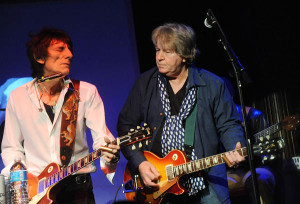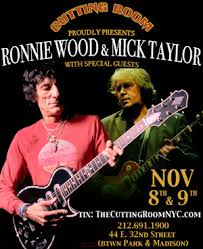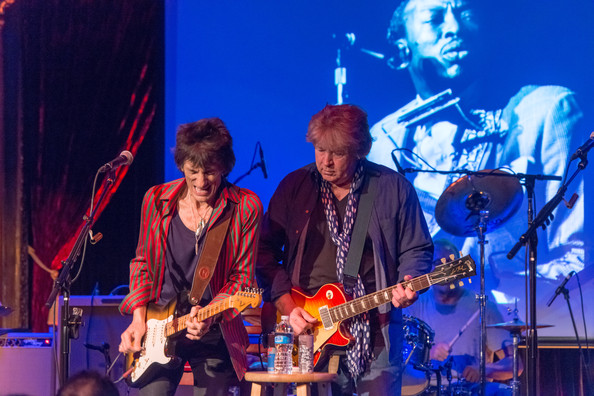RONNIE WOOD & MICK TAYLOR
Playing Jimmy Reed Tunes
One particularly music-knowledgeable witness of last week’s Ronnie Wood/Mick Taylor shows at the Cutting Room, which focused entirely on the music of the great Chicago bluesman Jimmy Reed and also featured Al Kooper on Hammond and Bad Company’s Simon Kirke on drums, was none other than the great Troy Sharmel.
That’s right, guitarist/pianist Troy Sharmel of the legendary Dr. Bop & the Headliners, whose real name is Robert Kenison, but whose friends curiously call him Beefy. Dr. Bop & the Headliners, the celebrated Midwest rock ’n’ roll show band of the 1970s, which famously featured vocalist Al Craven, the White Raven, and if they didn’t define rock ’n’ roll, they most certainly redefined it. In fact, they opened for bands like the New York Dolls, while bands like Cheap Trick (they had the same manager) opened for them.
Beefy, of course, was blown away by the Wood ensemble’s musicianship, and marveled especially at its employment of both acoustic and standup basses.
“You never see acoustic basses, outside of rockabilly or big bands or bluegrass,” said Beefy after the show. “And playing one together with an electric bassist, you have to be careful of hitting the notes at the same time, or else it sounds like mud.”
 The challenge for two bassists, Beefy explained, is “staying out of each other’s way: If you’re playing too low and you’re not on the same note, you can get all kinds of dissonance and low-frequency things that interfere with the sound.”
The challenge for two bassists, Beefy explained, is “staying out of each other’s way: If you’re playing too low and you’re not on the same note, you can get all kinds of dissonance and low-frequency things that interfere with the sound.”
Beefy noted, too, that the string bass gives the music a “warm sound,” like you hear on country music of the 1950s and ’60s.
“Listen to Ray Price or Patsy Cline’s ‘Walkin’ After Midnight’ and you hear a regular, warm stand-up. Maybe sometimes they’d use an electric bass to double a note and make a more mellow, thick and soft bottom. There even used to be a six-string electric bass guitar that was tuned down a whole lot to get those low notes. But this is the first time I’ve seen a rock band play with two basses, and it sounded great.”
The two basses gave Reed classics like “Going To New York,” “Big Boss Man,” “Bright Lights, Big City” and “Shame, Shame, Shame” “a nice bed for the music,” continued Beefy. As for the two guitar heroes, Wood and Taylor likewise “stayed out of each other’s way.”
 “When one took a solo, the other played in the background. They weren’t jumping on each other, so it worked out great—and the two basses gave them a good bed. But they were also playing old-style Chicago blues without a lot of distortion and newer effects—or many effects at all, for that matter. It was straight out-of-the-box guitar with amplifiers but no tricks or a lot of electronic effects, which was nice because it was true to that style of music.”
“When one took a solo, the other played in the background. They weren’t jumping on each other, so it worked out great—and the two basses gave them a good bed. But they were also playing old-style Chicago blues without a lot of distortion and newer effects—or many effects at all, for that matter. It was straight out-of-the-box guitar with amplifiers but no tricks or a lot of electronic effects, which was nice because it was true to that style of music.”
“What you heard is what they were doing,” Beefy concluded. “Steady, old-timey blues that you don’t hear much anymore, without a lot of gimmickry. And of course, it didn’t hurt to have a shot of Maker’s Mark before the show, either!”
At the end of Saturday night’s final show, incidentally, Wood stated that the experience of playing Jimmy Reed tunes with Taylor was his best-ever “non-Stones” gig.
Jim Bessman




comment closed